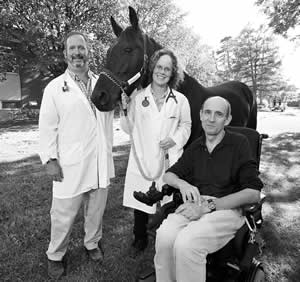ARCHIVE EQUINE NEWS STORIES
| Current news is available at TheHorsePortal.ca, Equine Guelph's online learning platform for practical, quick learning. Given the vast amount of information on horse health and welfare, Equine Guelph has archived its past news articles from 2002-2020. They are listed below, along with a search function available to find specific healthcare topics. | |
New medical technique garners international attentionNovember 2004

Dr. Dan Kenney (left), Dr. Kim McGurrin and Dr. Peter Physick-Sheard pose with Turner, the first horse treated using their new technique. Countless DVM students have listened to Turner’s irregular heartbeat, but now this teaching horse’s heart ailment has been cured by this new procedure.
- Photo by Martin Schwalbe
A new procedure for treating atrial fibrillation in horses gets right to the heart of the problem. The technique, developed by Dr. Physick-Sheard, graduate student Dr. Kim McGurrin, Clinical Studies, and Dr. Dan Kenney, Veterinary Teaching Hospital, uses catheter-mounted intracardiac electrodes to deliver a high-voltage jolt to the heart as a treatment for atrial fibrillation, also known as irregular heartbeat.
"When a horse has atrial fibrillation, the upper half of its heart twitches like a bag of worms rather than contracting regularly," says Physick-Sheard. "The heart is not as efficient, the heart rate can't get as high, and the result is severe underperformance."
The traditional treatment for atrial fibrillation is a drug treatment that has many side effects, such as depression, diarrhea, colic and low blood pressure, as well as a long recovery time. Physick-Sheard and McGurrin looked to human medicine for other options.
"A number of us around the clinic wondered if we could use shock to treat atrial fibrillation," says McGurrin, who developed the technique as part of her training in OVC's DVSc program. "At the time we were thinking of the paddles used in emergency situations for humans, but some research in human medicine showed that applying the shock internally is much more effective."
The technique involves threading two catheters through the veins of a horse into the right atrium and pulmonary artery. The catheters are fitted with electrodes, which must be placed very precisely before the shock is administered. The entire process, including anesthesia, takes about two hours, and has been effective in curing atrial fibrillation in all but one of the 27 horses that had this treatment to date.
The procedure, they found, carries only the normal potential adverse effects associated with anesthesia in horses - which, although rare, can include low blood pressure, problems with muscle perfusion and difficult anesthetic recoveries. Quick recovery time from treatment is one of the primary advantages of this new approach. While horses that undergo drug treatment for atrial fibrillation must abstain from any activity for seven to ten days afterward, horses whose owners choose electrical treatment can be doing light work within two days, and can resume their regular training schedule within one week.
The new technique also offers an alternative for the 10 to 15 percent of horses who do not respond to the drug treatment or cannot tolerate the agents used.
"Equine cardiology can be a lonely profession because we can diagnose so many conditions but treat so few," says Physick-Sheard. "The drug treatment for atrial fibrillation is difficult because the side-effects are so pronounced. Even low amounts of the drug cause depression. This new technique has been good news for many horse owners, and word has travelled."
Funded by the Grayson Jockey Club Foundation and the Ontario Ministry of Agriculture and Food, the new technique is garnering world-wide attention. McGurrin was recently invited to discuss the new technique at a human cardiology conference in France, and horses have come from Calgary and New Jersey to undergo treatment. Veterinary cardiologists have come from the University of Pennsylvania and the University of Ghent in Belgium to learn the technique, and McGurrin and Physick-Sheard have been invited to Cornell University to share their knowledge of this new alternative for treating atrial fibrillation.
In developing the novel technique, the researchers worked with Rhythm Technologies in California to develop the catheters, which have a fluid column in their centres that can be used along with an ultrasound to monitor cardiac pressure and catheter position. The researchers are currently obtaining a patent on the specialized, single-use catheters, which also have potential for use in human medicine.
- Karen Gallant